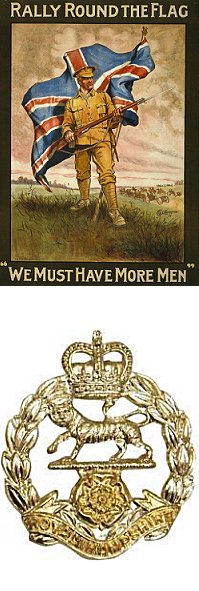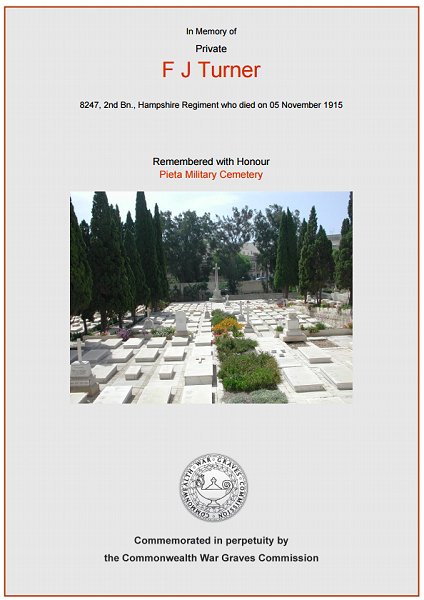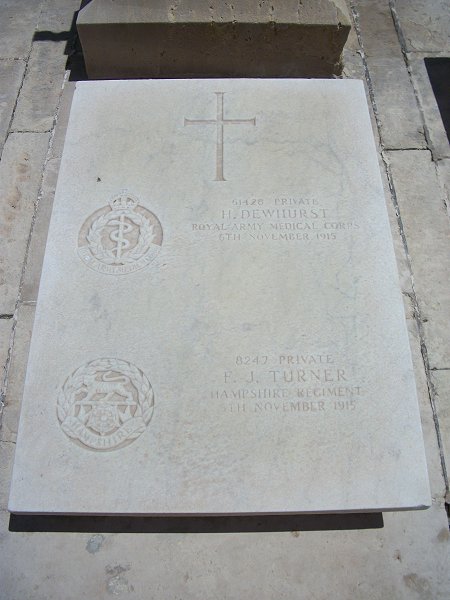yeovil at War
Frederick James Turner
Died of pneumonia in Malta
Frederick James Turner was born in Yeovil in 1890, the youngest child of farm labourer George Turner (b1851) and Emma née Rowe (1855-1941). George and Emma were to have seven children: Bessie Georgina (1876-1957), Sarah Anne (b1878), William George (b1880), Albert John (b1882), Walter Charles (b1885), Tom Henry (b1887) and Frederick. By 1891 the family had moved to East Knoyle, Wiltshire and by 1901 they had moved again to West Stour, Dorset, where George worked as a cattleman on a farm.
 Frederick
enlisted at
Bournemouth,
giving his
address as
Moordown,
Hampshire. He
joined the 2nd
Battalion,
Hampshire
Regiment. His
Service Number
8247 indicates
that he enlisted
in October 1908.
Frederick
enlisted at
Bournemouth,
giving his
address as
Moordown,
Hampshire. He
joined the 2nd
Battalion,
Hampshire
Regiment. His
Service Number
8247 indicates
that he enlisted
in October 1908.
At this time his battalion were in South Africa and he presumably joined them there after his basic training in England. The Battalion remained in South Africa until 1911 when they moved to Mauritius.
The Mauritius posting lasted two years and the Battalion was next shipped to India. The 2nd Battalion The Hampshire Regiment had only eight months in India when war broke out. On 31 August 1914 it was directed to leave Mhow at once for Bombay to take over from the Sherwood Foresters.
The
Battalion stayed
at Colaba (where
they removed
ammo from a ship
on fire in the
dockyard) until
the middle of
November, when
the 1/7th
Hampshire
relieved them.
In all 21
officers, 43
sergeants, 15
drummers, and
816 rank and
file boarded the
Gloucester
Castle on
16 November and
headed for
England. On 22
December 1914
the convoy
reached
Plymouth, then
Romsey. They
joined the 29th
Division and
were attached to
the 88th Brigade
at
Stafford-on-Avon
and Warwick. In
early 1915 the
battalion became
part of the 88th
Brigade,
assigned to the
29th Division.
The 2nd
Hampshire were
supplied with 2
drafts of men,
181 on 31
January 1915,
and 50 on 20
February. It was
at first
allotted for
France, but then
was dispatched
to Gallipoli,
and embarked on
28 March 1915.
Before they left
on 20 March 1915
the whole
division passed
in review of the
King. W and X
companies
embarked on the
H.T. Aragon,
Y and Z in the
Manitou,
26 officers, 993
other ranks.
Calling in Malta
on 2 April 1915.
The Gallipoli Campaign, also known as the Dardanelles Campaign, was a campaign that took place on the Gallipoli peninsula in the Ottoman Empire between 25 April 1915 and 9 January 1916. The peninsula forms the northern bank of the Dardanelles, a strait that provides a sea route to what was then the Russian Empire. Intending to secure it, Russia's allies Britain and France launched a naval attack followed by an amphibious landing on the peninsula with the eventual aim of capturing the Ottoman capital of Constantinople (modern-day Istanbul). The naval attack was repelled and, after eight months' fighting, with many casualties on both sides, the land campaign also failed and the invasion force was withdrawn to Egypt. The campaign was one of the greatest Ottoman victories during the war and a major Allied failure.
Frederick was taken ill while in Gallipoli and was transported to a military hospital in Malta. He died from pneumonia in Malta on 5 November 1915. He was aged 25.
Frederick Turner was buried in the Pieta Military Cemetery, Malta, Grave D.III.3. His name was added to the War Memorial in the Borough in 2018.
gallery

The Commonwealth War Graves Commission certificate in memory of Frederick Turner.

Frederick Turner's grave in the Pieta Military Cemetery, Malta.